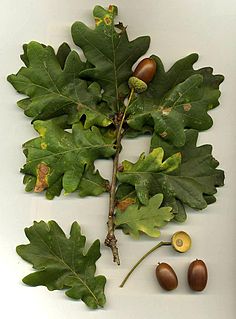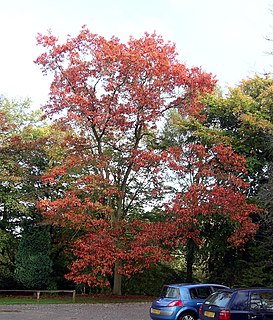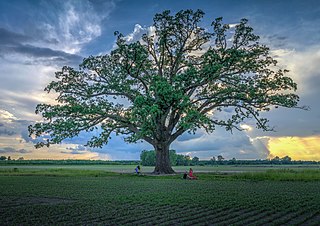
An oak is a tree or shrub in the genus Quercus of the beech family, Fagaceae. There are approximately 500 extant species of oaks. The common name "oak" also appears in the names of species in related genera, notably Lithocarpus, as well as in those of unrelated species such as Grevillea robusta and the Casuarinaceae (she-oaks). The genus Quercus is native to the Northern Hemisphere, and includes deciduous and evergreen species extending from cool temperate to tropical latitudes in the Americas, Asia, Europe, and North Africa. North America has the largest number of oak species, with approximately 160 species in Mexico of which 109 are endemic and about 90 in the United States. The second greatest area of oak diversity is China, with approximately 100 species.

Quercus rubra, the northern red oak, is an oak tree in the red oak group. It is a native of North America, in the eastern and central United States and southeast and south-central Canada. It grows from the north end of the Great Lakes, east to Nova Scotia, south as far as Georgia, Mississippi, Alabama, and Louisiana, and west to Oklahoma, Kansas, Nebraska, and Minnesota. It has been introduced to small areas in Western Europe, where it can frequently be seen cultivated in gardens and parks. It prefers good soil that is slightly acidic. Often simply called red oak, northern red oak is so named to distinguish it from southern red oak, also known as the Spanish oak. Northern Red Oak is sometimes called champion oak. It is also the state tree of New Jersey and the provincial tree of Prince Edward Island.

Quercus montana, the chestnut oak, is a species of oak in the white oak group, Quercus sect. Quercus. It is native to the eastern United States, where it is one of the most important ridgetop trees from southern Maine southwest to central Mississippi, with an outlying northwestern population in southern Michigan. It is also sometimes called rock oak because of its presence in montane and other rocky habitats. As a consequence of its dry habitat and ridgetop exposure, it is not usually a large tree, typically 18–22 m (59–72 ft) tall; occasional specimens growing in better conditions can, however, become large, with trees up to 40–43 m (131–141 ft) tall known. They tend to have a similar spread of 18–22 m (59–72 ft). A 10-year-old sapling grown in full sun will stand about 5 m (16 ft) tall. This species is often an important canopy species in an oak-heath forest.

Quercus alba, the white oak, is one of the preeminent hardwoods of eastern and central North America. It is a long-lived oak, native to eastern and central North America and found from Minnesota, Ontario, Quebec, and southern Maine south as far as northern Florida and eastern Texas. Specimens have been documented to be over 450 years old.

Quercus velutina, the black oak, is a species of oak in the red oak group, native and widespread in eastern and central North America. It is found in all the coastal states from Maine to Texas, inland as far as Michigan, Ontario, Minnesota, Nebraska, Kansas, Oklahoma, and eastern Texas. It is sometimes called the eastern black oak.

Quercus bicolor, the swamp white oak, is a North American species of medium-sized trees in the beech family. It is a common element of America's north central and northeastern mixed forests. It can survive in a variety of habitats. It forms hybrids with bur oak where they occur together in the wild.
The white oaks are species of trees in the genus Quercus section Quercus.
Red oaks are tree species in the genus Quercus section Lobatae.

Quercus macrocarpa, the bur oak, commonly spelled burr oak, is a species of oak tree native to eastern North America. It is in the white oak section, Quercus sect. Quercus, and is also called mossycup oak, mossycup white oak, blue oak, or scrub oak. The acorns are the largest of any North American oak, and are important food for wildlife.

Quercus shumardii, the Shumard oak, spotted oak, Schneck oak, Shumard red oak, or swamp red oak, is one of the largest of the oak species in the red oak group. It is closely related to Quercus buckleyi, Quercus texana, and Quercus gravesii.

Quercus coccinea, the scarlet oak, is a deciduous tree in the red oak section Lobatae of the genus Quercus, in the family Fagaceae. It can be mistaken for the pin oak, the black oak, or occasionally the red oak. On the scarlet oak the sinuses between lobes are "C"-shaped in comparison to pin oak, Quercus palustris, which has U-shaped sinuses and the acorns are half covered by a deep cap.

The Appalachian–Blue Ridge forests are an ecoregion in the Temperate broadleaf and mixed forests Biome, in the Eastern United States. The ecoregion is located in the central and southern Appalachian Mountains, including the Ridge-and-Valley Appalachians and the Blue Ridge Mountains. It covers an area of about 61,500 square miles (159,000 km2) in: northeast Alabama and Georgia, northwest South Carolina, eastern Tennessee, western North Carolina, Virginia, Maryland, and central West Virginia and Pennsylvania; and small extensions into Kentucky, New Jersey, and New York.

Quercus ilicifolia, commonly known as bear oak or scrub oak, is a small shrubby oak native to the eastern United States and southeastern Canada. Its range extends in the United States from Maine to North Carolina, with reports of a few populations north of the international frontier in Ontario. The name ilicifolia means "holly-leaved."
An oak–heath forest is a plant community association and type of forest ecology. It is a deciduous forest type of well-drained, acidic soils, characterized by oaks (Quercus) and plants of the heath family (Ericaceae). It is commonly found in the high elevations of the eastern United States. Such forest areas typically have a dense fibrous root layer at the surface of the soil, and in many areas predominate on south-facing or southwest-facing slopes. Many of the existing oak–heath forests once featured American chestnut as an important canopy species.

Quercus oleoides, with Spanish common names encina or encino, is a Mesoamerican species of oak in the white oak group. It grows in dry forests and pastureland of eastern and southern Mexico and much of Central America, from Guanacaste Province in Costa Rica north as far as the State of Tamaulipas in northeastern Mexico.

Acleris subnivana, the common acleris, is a species of moth of the family Tortricidae. It is found in North America, where it has been recorded from Arkansas, Illinois, Indiana, Kentucky, Maine, Maryland, Massachusetts, Michigan, Mississippi, New Brunswick, New Hampshire, New York, North Carolina, Ohio, Oklahoma, Ontario, Pennsylvania, Quebec, South Carolina, Tennessee, West Virginia and Wisconsin.

Quercus sinuata is a North American species of oak comprising two distinct varieties, Quercus sinuata var. sinuata and Quercus sinuata var. breviloba. Morphologically intermediate forms may occur where range overlap brings the two taxa together. Quercus sinuata var. breviloba is native to central and north central Texas, south central and southwest Oklahoma, and to Coahuila, Nuevo León, and Tamaulipas in northern Mexico. Quercus sinuata var. sinuata is native to the south-central and southeastern United States from central Texas and southwestern Arkansas to the Carolinas. Their respective ranges intersect in the Hill Country of central Texas, where streams flowing through dry, brushy limestone hills create a mosaic of wet and well drained habitats.
Menesta astronoma is a moth in the Depressariidae family found in Bolivia. It was described by Edward Meyrick in 1909. It is
Menesta tortriciformella is a moth in the family Depressariidae. It was described by James Brackenridge Clemens in 1860. It is found in North America, where it has been recorded from Florida, Georgia, Illinois, Kentucky, Maryland, Mississippi, New Hampshire, New Jersey, New York, Ohio, Pennsylvania, Virginia, Ontario, Nova Scotia.














